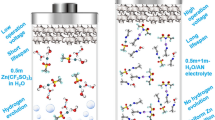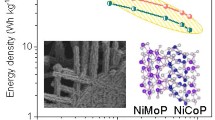Abstract
The increasing use of fossil fuels and resulting environmental concerns have elevated the global issues, leading to a focus on developing alternative sustainable energy sources. However, supercapacitors (SCs) have been considered as possible solutions to address major global energy challenges. These devices are designed to generate and store energy efficiently. In this study, Mn-doped MnO2 material was fabricated utilizing the simple hydrothermal route to increase the electrochemical efficiency of MnO2 by doping strategy. However, the properties of the Mn-doped MnO2 material were analyzed with different analytical tools. The electrochemical result of Mn-doped MnO2 was determined, which revealed higher specific capacitance of 920.86 F g−1 than MnO2 (512.90 F g−1) at 1 A g−1 with low charge transfer resistance of Rct = 0.9 Ω. Furthermore, Mn-doped MnO2 exhibited exceptional stability of 50 h with capacitive retention of 97.14% after the 5000th cycle and contains a larger surface area with diverse morphology, which was responsible for the enhanced capacitive performance for use in various fields of energy storage applications.






Similar content being viewed by others
References
W. Jiang, X. Wang, H. Huang, D. Zhang, N. Ghadimi, Optimal economic scheduling of microgrids considering renewable energy sources based on energy hub model using demand response and improved water wave optimization algorithm. J Energy Storage 55, 105311 (2022). https://doi.org/10.1016/J.EST.2022.105311
ur Rehman U, Yaqoob K, Adil Khan M. Optimal power management framework for smart homes using electric vehicles and energy storage. Int J Electr Power Energy Syst 2022;134:107358. https://doi.org/10.1016/J.IJEPES.2021.107358.
L.L. da Silva, M. Quartier, A. Buchmayr, D. Sanjuan-Delmás, H. Laget, D. Corbisier et al., Life cycle assessment of lithium-ion batteries and vanadium redox flow batteries-based renewable energy storage systems. Sustain Energy Technol Assessments 46, 101286 (2021). https://doi.org/10.1016/J.SETA.2021.101286
L. Zhang, X.S. Zhao, Carbon-based materials as supercapacitor electrodes. Chem. Soc. Rev. 38, 2520–2531 (2009). https://doi.org/10.1039/B813846J
H.N. Heme, M.S.N. Alif, S.M.S.M. Rahat, S.B. Shuchi, Recent progress in polyaniline composites for high capacity energy storage: A review. J Energy Storage 42, 103018 (2021). https://doi.org/10.1016/J.EST.2021.103018
M. Hussain, M.M. Alanazi, S.A.M. Abdelmohsen, S.D. Alahmari, M. Abdullah, S. Aman et al., Enhanced performance of hydrothermally prepared Ag2Se/rGO nanosheet composite for energy storage applications. Diam. Relat. Mater. 142, 110764 (2024). https://doi.org/10.1016/J.DIAMOND.2023.110764
J. Jiang, Y. Li, J. Liu, X. Huang, C. Yuan, X.W. Lou, Recent advances in metal oxide-based electrode architecture design for electrochemical energy storage. Adv. Mater. 24, 5166–5180 (2012). https://doi.org/10.1002/ADMA.201202146
J. Cherusseri, D. Pandey, K. Sambath Kumar, J. Thomas, L. Zhai, Flexible supercapacitor electrodes using metal–organic frameworks. Nanoscale 12, 17649–17662 (2020). https://doi.org/10.1039/D0NR03549A
D. Zha, P. Xiong, X. Wang, Strongly coupled manganese ferrite/carbon black/polyaniline hybrid for low-cost supercapacitors with high rate capability. Electrochim. Acta 185, 218–228 (2015). https://doi.org/10.1016/J.ELECTACTA.2015.10.139
F. Li, H. Chen, X.Y. Liu, S.J. Zhu, J.Q. Jia, C.H. Xu et al., Low-cost high-performance asymmetric supercapacitors based on Co2AlO4@MnO2 nanosheets and Fe3O4 nanoflakes. J Mater Chem A 4, 2096–2104 (2016). https://doi.org/10.1039/C5TA09914E
Z. Pan, Z. Lu, L. Xu, D. Wang, A robust 2D porous carbon nanoflake cathode for high energy-power density Zn-ion hybrid supercapacitor applications. Appl. Surf. Sci. 510, 145384 (2020). https://doi.org/10.1016/J.APSUSC.2020.145384
Y. Zhang, J. Liu, S.L. Li, Z.M. Su, Y.Q. Lan, Polyoxometalate-based materials for sustainable and clean energy conversion and storage. EnergyChem 1, 100021 (2019). https://doi.org/10.1016/J.ENCHEM.2019.100021
J. Sahu, S. Kumar, F. Ahmed, P.A. Alvi, B. Dalela, D.M. Phase et al., Electrochemical properties of high-performance supercapacitor based on Nd-Doped Zno nanoparticles and electronic structure investigated with Xas. SSRN Electron. J. (2022). https://doi.org/10.2139/SSRN.4114229
N. Parveen, S.A. Ansari, M.Z. Ansari, M.O. Ansari, Manganese oxide as an effective electrode material for energy storage: a review. Environ. Chem. Lett. 20, 283–309 (2022). https://doi.org/10.1007/S10311-021-01316-6/FIGURES/12
P. Siwatch, K. Sharma, N. Singh, N. Manyani, S.K. Tripathi, Enhanced supercapacitive performance of reduced graphene oxide by incorporating NiCo2O4 quantum dots using aqueous electrolyte. Electrochim. Acta 381, 138235 (2021). https://doi.org/10.1016/J.ELECTACTA.2021.138235
L. Cao, H. Li, X. Liu, S. Liu, L. Zhang, W. Xu et al., Nitrogen, sulfur co-doped hierarchical carbon encapsulated in graphene with “sphere-in-layer” interconnection for high-performance supercapacitor. J. Colloid Interface Sci. 599, 443–452 (2021). https://doi.org/10.1016/j.jcis.2021.04.105
M. Ali, S.D. Alahmari, S.A.M. Abdelmohsen, M.M. Alanazi, A.G. Al-Sehemi, M. Abdullah et al., Fabrication of MnSe/WSe2 nanohybrid electrode prepared through hydrothermal method for supercapacitor applications. Ceram. Int. 50, 6931–6940 (2024). https://doi.org/10.1016/J.CERAMINT.2023.12.042
M. Hussain, S.D. Alahmari, F.F. Alharbi, S.R. Ejaz, M. Abdullah, S. Aman et al., Hydrothermal synthesis of the NiS@g-C3N4 nanohybrid electrode material for supercapacitor applications. J Energy Storage 80, 110289 (2024). https://doi.org/10.1016/J.EST.2023.110289
S. Korkmaz, A. Kariper, O. Karaman, C. Karaman, The production of rGO/ RuO2 aerogel supercapacitor and analysis of its electrochemical performances. Ceram. Int. 47, 34514–34520 (2021). https://doi.org/10.1016/J.CERAMINT.2021.08.366
S. Shivakumara, T.R. Penki, N. Munichandraiah, Synthesis and characterization of porous flowerlike ?-fe2o3 nanostructures for supercapacitor application. ECS Electrochem Lett 2, A60 (2013). https://doi.org/10.1149/2.002307EEL/XML
N. Kandasamy, T. Venugopal, K. Kannan, Facile One-Pot Synthesis of Flower Like Cobalt Oxide Nanostructures on Nickel Plate and Its Supercapacitance Properties. J. Nanosci. Nanotechnol. 18, 3960–3968 (2017). https://doi.org/10.1166/JNN.2018.15187
S. Vijayakumar, S. Nagamuthu, G. Muralidharan, Supercapacitor studies on NiO nanoflakes synthesized through a microwave route. ACS Appl. Mater. Interfaces 5, 2188–2196 (2013). https://doi.org/10.1021/AM400012H/SUPPL_FILE/AM400012H_SI_001.PDF
D. Kalpana, K.S. Omkumar, S.S. Kumar, N.G. Renganathan, A novel high power symmetric ZnO/carbon aerogel composite electrode for electrochemical supercapacitor. Electrochim. Acta 52, 1309–1315 (2006). https://doi.org/10.1016/J.ELECTACTA.2006.07.032
S. Tajik, H. Beitollahi, Z. Dourandish, P. Mohammadzadeh Jahani, I. Sheikhshoaie, M.B. Askari et al., Applications of non-precious transition metal oxide nanoparticles in electrochemistry. Electroanalysis 34, 1065–1091 (2022). https://doi.org/10.1002/ELAN.202100393
L. Wang, X. Wang, X. Xiao, F. Xu, Y. Sun, Z. Li, Reduced graphene oxide/nickel cobaltite nanoflake composites for high specific capacitance supercapacitors. Electrochim. Acta 111, 937–945 (2013). https://doi.org/10.1016/J.ELECTACTA.2013.08.094
T. Yu, Z. Zhao, L. Liu, S. Zhang, H. Xu, G. Yang, TiC3 monolayer with high specific capacity for sodium-ion batteries. J. Am. Chem. Soc. 140, 5962–5968 (2018). https://doi.org/10.1021/JACS.8B02016/SUPPL_FILE/JA8B02016_SI_001.PDF
W. Deng, X. Ji, Q. Chen, C.E. Banks, Electrochemical capacitors utilising transition metal oxides : an update of recent developments. RSC Adv. 1, 1171–1178 (2011). https://doi.org/10.1039/C1RA00664A
Q.Z. Zhang, D. Zhang, Z.C. Miao, X.L. Zhang, S.L. Chou, Research progress in MnO2–carbon based supercapacitor electrode materials. Small 14, 1702883 (2018). https://doi.org/10.1002/SMLL.201702883
Petros RA, Desimone JM. Strategies in the design of nanoparticles for therapeutic applications. Nat Rev Drug Discov 2010 98 2010;9:615–27. https://doi.org/10.1038/nrd2591.
F. Tang, L. Li, D. Chen, Mesoporous silica nanoparticles: synthesis, biocompatibility and drug delivery. Adv. Mater. 24, 1504–1534 (2012). https://doi.org/10.1002/ADMA.201104763
W. Wang, F. Lv, B. Lei, S. Wan, M. Luo, S. Guo, Tuning nanowires and nanotubes for efficient fuel-cell electrocatalysis. Adv. Mater. 28, 10117–10141 (2016). https://doi.org/10.1002/ADMA.201601909
X. Feng, D. Ren, X. He, M. Ouyang, Mitigating thermal runaway of lithium-ion batteries. Joule 4, 743–770 (2020). https://doi.org/10.1016/J.JOULE.2020.02.010
Cea C, Spyropoulos GD, Jastrzebska-Perfect P, Ferrero JJ, Gelinas JN, Khodagholy D. Enhancement-mode ion-based transistor as a comprehensive interface and real-time processing unit for in vivo electrophysiology. Nat Mater 2020 196 2020;19:679–86. https://doi.org/10.1038/s41563-020-0638-3.
G. Di Liberto, S. Tosoni, G. Pacchioni, Theoretical treatment of semiconductor heterojunctions for photocatalysis: the WO3/BiVO4 interface. J. Phys. Condens. Matter 31, 434001 (2019). https://doi.org/10.1088/1361-648X/AB2FA4
A.E. Cassano, O.M. Alfano, Reaction engineering of suspended solid heterogeneous photocatalytic reactors. Catal. Today 58, 167–197 (2000). https://doi.org/10.1016/S0920-5861(00)00251-0
S. Singh, H. Mahalingam, P.K. Singh, Polymer-supported titanium dioxide photocatalysts for environmental remediation: a review. Appl Catal A Gen 462–463, 178–195 (2013). https://doi.org/10.1016/J.APCATA.2013.04.039
R. Gao, D. Yan, Recent development of Ni/Fe-based micro/nanostructures toward photo/electrochemical water oxidation. Adv. Energy Mater. 10, 1900954 (2020). https://doi.org/10.1002/AENM.201900954
Z. Liu, F. Wang, Z. Zhang, S. Min, Interfacing CdS particles on Ni foam as a three-dimensional monolithic photocatalyst for efficient visible-light-driven H2 evolution. Int. J. Hydrogen Energy 45, 31678–31688 (2020). https://doi.org/10.1016/J.IJHYDENE.2020.09.031
X. Meng, C. Zhang, C. Dong, W. Sun, D. Ji, Y. Ding, Carbon quantum dots assisted strategy to synthesize Co@NC for boosting photocatalytic hydrogen evolution performance of CdS. Chem. Eng. J. 389, 124432 (2020). https://doi.org/10.1016/J.CEJ.2020.124432
D. Yan, Z. Guo, G. Zhu, Z. Yu, H. Xu, A. Yu, MnO2 film with three-dimensional structure prepared by hydrothermal process for supercapacitor. J. Power. Sources 199, 409–412 (2012). https://doi.org/10.1016/J.JPOWSOUR.2011.10.051
X. Su, L. Yu, G. Cheng, H. Zhang, M. Sun, L. Zhang et al., Controllable hydrothermal synthesis of Cu-doped δ-MnO2 films with different morphologies for energy storage and conversion using supercapacitors. Appl. Energy 134, 439–445 (2014). https://doi.org/10.1016/J.APENERGY.2014.08.050
R. Zhong, M. Xu, N. Fu, R. Liu, A. Zhou, X. Wang et al., A flexible high-performance symmetric quasi-solid supercapacitor based on Ni-doped MnO2 nano-array @ carbon cloth. Electrochim. Acta 348, 136209 (2020). https://doi.org/10.1016/J.ELECTACTA.2020.136209
Q. Gao, J. Wang, B. Ke, J. Wang, Y. Li, Fe doped δ-MnO2 nanoneedles as advanced supercapacitor electrodes. Ceram. Int. 44, 18770–18775 (2018). https://doi.org/10.1016/J.CERAMINT.2018.07.108
M.U. Nisa, A.G. Abid, S. Gouadria, T. Munawar, Z.A. Alrowaili, M. Abdullah et al., Boosted electron-transfer/separation of SnO2/CdSe/Bi2S3 heterostructure for excellent photocatalytic degradation of organic dye pollutants under visible light. Surfaces Interfaces 31, 102012 (2022). https://doi.org/10.1016/J.SURFIN.2022.102012
M. Abdullah, P. John, S. Manzoor, M.I. Ghouri, H.H. Hegazy, A.H. Chugtai et al., Facile fabrication of CuO/Ag2Se nanosized composite via hydrothermal approach for the electrochemical energy conversion system. J Energy Storage 56, 105929 (2022). https://doi.org/10.1016/J.EST.2022.105929
S. Kumar, G. Saeed, L. Zhu, K.N. Hui, N.H. Kim, J.H. Lee, 0D to 3D carbon-based networks combined with pseudocapacitive electrode material for high energy density supercapacitor: a review. Chem. Eng. J. 403, 126352 (2021). https://doi.org/10.1016/J.CEJ.2020.126352
Z. Zeng, P. Sun, J. Zhu, X. Zhu, Ag-doped manganese oxide prepared by electrochemical deposition on carbon fiber for supercapacitors. RSC Adv. 5, 17550–17558 (2015). https://doi.org/10.1039/C4RA16646A
G. Li, X. Xu, R. Han, J. Ma, Synthesis and superior electrochemical properties of shaggy hollow Zn-doped Fe2O3 nanospheres for high-performance lithium-ion batteries. CrystEngComm 18, 2949–2955 (2016). https://doi.org/10.1039/C5CE02408K
M. Ali, S.D. Alahmari, S.A.M. Abdelmohsen, M.M. Alanazi, A.G. Al-Sehemi, M. Abdullah et al., Fabrication of MnSe/WSe2 nanohybrid electrode prepared through hydrothermal method for supercapacitor applications. Ceram. Int. (2023). https://doi.org/10.1016/J.CERAMINT.2023.12.042
A. Singh, D. Kumar, B. Singh, V. Shinde, R. Kaur, Fractal analysis of pure and Fe-doped manganese oxide supercapacitor electrodes. Prot Met Phys Chem Surfaces 58, 991–998 (2022). https://doi.org/10.1134/S2070205122050240/FIGURES/6
M. Parthibavarman, M. Karthik, P. Sathishkumar, R. Poonguzhali, Rapid synthesis of novel Cr-doped WO3 nanorods: an efficient electrochemical and photocatalytic performance. J. Iran. Chem. Soc. 15, 1419–1430 (2018). https://doi.org/10.1007/S13738-018-1342-Y/FIGURES/13
A.V. Radhamani, M. Krishna Surendra, M.S.R. Rao, Zn doped δ-MnO2 nano flakes: An efficient electrode material for aqueous and solid state asymmetric supercapacitors. Appl. Surf. Sci. 450, 209–218 (2018). https://doi.org/10.1016/J.APSUSC.2018.04.081
F. Iram, G.M. Mustafa, G. Ali, H. Ahmad, S.M. Ramay, Z. Iqbal et al., Transition metal (Zn, Mn, and Ni) incorporated CuO nanostructures for supercapacitor applications. J Energy Storage 73, 108829 (2023). https://doi.org/10.1016/J.EST.2023.108829
Acknowledgements
Princess Nourah bint Abdulrahman University Researchers Supporting Project number (PNURSP2024R55), Princess Nourah bint Abdulrahman University, Riyadh, Saudi Arabia.
Author information
Authors and Affiliations
Contributions
All the authors have contributed equally.
Corresponding author
Ethics declarations
Declarations
Yes, this paper complies with the journal's ethical guidelines.
Conflict of interest
The authors state that there is no conflict in their work.
Research data policy and Data Availability statements
On reasonable request, the author will make the datasets created during and/or analyzed during the current investigation.
Additional information
Publisher's Note
Springer Nature remains neutral with regard to jurisdictional claims in published maps and institutional affiliations.
Rights and permissions
Springer Nature or its licensor (e.g. a society or other partner) holds exclusive rights to this article under a publishing agreement with the author(s) or other rightsholder(s); author self-archiving of the accepted manuscript version of this article is solely governed by the terms of such publishing agreement and applicable law.
About this article
Cite this article
Alharbi, F.F., Abdullah, M., Aman, S. et al. Development of environmental friendly Mo-doped MnO2 via hydrothermal route for supercapacitor as pollution-free source of energy. Appl. Phys. A 130, 236 (2024). https://doi.org/10.1007/s00339-024-07359-0
Received:
Accepted:
Published:
DOI: https://doi.org/10.1007/s00339-024-07359-0




